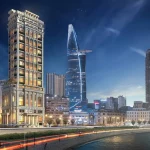Savills Asia Pacific has just released a report on the recovery potential of the property market in Asia Pacific amid the new Covid-19 wave. The report said that industrial real estate is classified as an “upper door” compared to the rest of the market by attracting a lot of attention from investors. This unit said that most segments of the real estate market are witnessing a large decrease in the number of transactions, causing many investors to change their plans and operations to overcome the period. this difficulty. However, the industrial sector has consistently shown positive change while still attracting great attention, being rated as the only area that promises high resilience and rapid acceleration.
This unit said that most segments of the real estate market are witnessing a large decrease in the number of transactions, causing many investors to change their plans and operations to overcome the period. this difficulty. However, the industrial sector has consistently shown positive change while still attracting great attention, being rated as the only area that promises high resilience and rapid acceleration.
Data from Real Capital Analytics shows office real estate transactions in Asia Pacific were down 59% through the second quarter compared to the same period last year. For retail real estate, the number is even more worrying, the decrease is up to 68%. However, industrial real estate transactions and the forwarding and logistics industries fell only 24%, showing that this is a group that is less affected than the rest of the market and transactions facing a chance of rapid recovery. right during a pandemic.
Mr. Simon Smith, Head of Research and Consulting at Savills Asia Pacific, said that industrial real estate is being interested and sought by many investors. The industry is closely related to strong trends such as the growth of e-commerce, and virtually every market in the region lacks modern logistics space.
According to Savills Pacific, industrial real estate has been and is a group of assets with the ability to recover and increase heat in most markets in Asia Pacific, in which the key areas include: Vietnam, India and China.
Based on data from Focus Economics, Vietnam’s index of industrial production (IIP) saw output in June increase 7.0% year-on-year, mainly due to a recovery in commodity production. chemistry and electricity generation. Industrial and manufacturing output is estimated to increase 2.71% in 2020 (and is expected to increase 9.2% by 2021), indicating modest but promising growth in this sector.
In addition, the purchasing power management index (PMI) also soared to 51.1 points in June, with 42.7 points in May, marking the first growth above the 50-point threshold since May. 1 after the Government’s success in containment and pandemic prevention. This recovery is attributed to a sharp increase in new orders, positive purchasing activity and the highest rise in pre-production inventories since November 2018.
In June, the country had 336 industrial zones with a total area of about 97,800 hectares. In which, 261 industrial zones are in operation and the remaining 75 are in the process of site clearance and construction begins. Occupancy rate reached 76% of the total operating industrial parks nationwide.
Mr. John Campbell, Head of Industrial Real Estate Division, Savills Vietnam, said that with great demand continues to exceed supply, the need to increase the number of supplies in industrial areas can be seen. key point. The occupancy in key regions in the South such as Binh Duong, Dong Nai, Long An, and the North such as Bac Ninh, Hung Yen, Hai Phong has increased significantly since 2018.
Most leasing transactions in the first half of 2020 originate from projects and the negotiations took place since last year. Meanwhile, many leases are made by companies already in Vietnam and are looking to expand production.
Policies restricting travel between countries affected the need to enter the market, delayed ground surveys by large international investors, and caused the number of leases to be signed. Limited domestic developers. Vietnamese industry is benefiting from the supply chain shift away from China and many industrial park owners are preparing resources to take on the coming opportunities as soon as barriers are lifted.
For India, because it is still in a blockade due to Covid-19, every business in this country suffers, but the future of the industrial real estate industry here is more promising than other industries. The industry is expected to benefit as multinational companies look for new locations for production. India has also gradually been seen as an alternative producer of Chinese goods. There are about 1,000 foreign manufacturing companies planning to move their main production base from China to India, of which 300 companies have plans to manufacture mobile goods, electronics, medical equipment, and textiles. sewing. The Indian government is actively attracting foreign companies and in an effort to boost domestic production growth, the Government of India has just cut corporate taxes. This resonates with attractive goods & services tax and the advantage of cheap labor, India is actively encouraging and attracting foreign companies to relocate their factories to their own countries.
With the Chinese market, although it is first affected by the Covid-19 epidemic, this billion-population market is gradually recovering, the industrial real estate industry in each economic region of this country is seeing different challenges.
In Wuhan, at the heart of the epidemic, all business activities are restricted, especially logistics operations, and this trend continues. Investor interest has decreased due to fear of disease risks, but some investors are preparing for a market bottom.
However, in the South China region, market demand remained high during the pandemic. Significant increase in demand from suppliers of fresh food, online sales, and the health care industry has contributed to support the recent development of the logistics market.
In the provinces of Jiangsu, Zhejiang and Shanghai, the impact of the pandemic on these areas is not severe and industrial property developers continue to build new spaces. A large volume of warehouses is expected to continue to launch over the next 12-24 months. The industrial real estate market in the tier I and II cities is growing and homeowners are ready to rent out while the project is still under construction.
Savills forecasts that Covid-19 is promoting an increase in the supply of industrial real estate because local authorities have to find ways to increase income and production. One of the consequences of the pandemic was that many manufacturing companies developed problems and adjusted business plans, forcing local governments to increase land supplies. This is an opportunity for logistics businesses to acquire a quality industrial land fund with a beautiful location.





